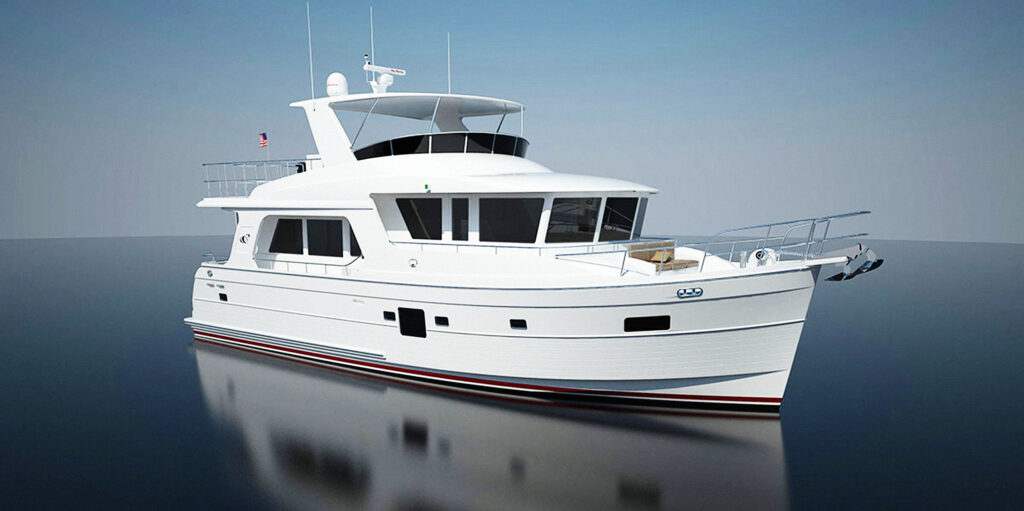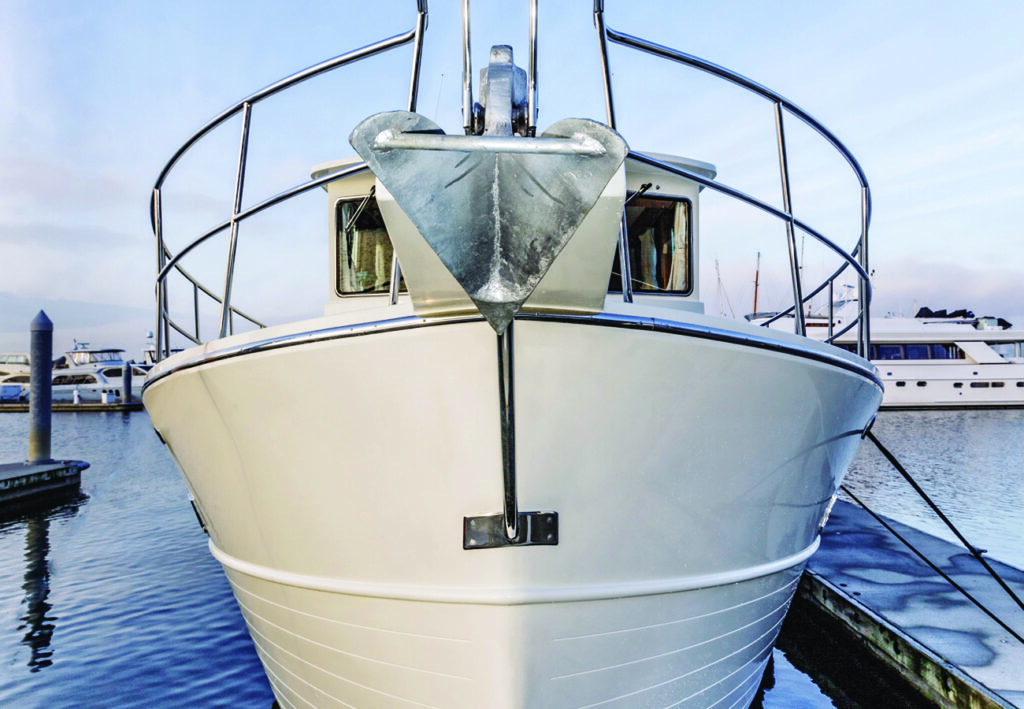At North Pacific Yachts, we understand that maintaining a yacht’s hull is essential to preserving both its performance and longevity. A well-maintained hull enhances hydrodynamics, reduces fuel consumption, and protects against long-term structural issues. Cleaning the hull regularly prevents marine growth from accumulating, which can slow the vessel down and lead to costly repairs over time. We emphasize the use of environmentally friendly cleaning products that effectively remove biofouling without harming marine ecosystems. Whether it’s routine in-water cleaning or a full haul-out for more intensive maintenance, our approach ensures that every yacht remains in peak condition for smooth, efficient sailing.
Beyond cleaning, proper hull painting plays a crucial role in both aesthetics and protection. High-quality marine coatings help prevent corrosion, osmosis, and UV damage while also reducing drag for better performance. Anti-fouling paints, specifically selected based on the yacht’s operating environment, create a protective barrier against barnacles, algae, and other marine organisms that attach to the hull. Regular inspections allow us to determine when a fresh coat is needed, ensuring the hull remains in optimal shape. With our expertise in yacht construction and maintenance, we guide owners in choosing the best coatings and protective measures to extend the lifespan of their investment while maintaining top-tier craftsmanship and performance.

Understanding Yacht Hull Maintenance
Maintaining a yacht’s hull is critical for ensuring its longevity, performance, and efficiency. Proper hull care minimizes structural degradation, improves fuel economy, and enhances the yacht’s aesthetic appeal. Regular maintenance prevents damage caused by marine growth, corrosion, and physical impacts.
The Importance of Hull Care for Longevity
Neglecting hull maintenance can lead to severe structural integrity issues, such as delamination in fiberglass hulls, corrosion in aluminum and steel hulls, and rot in wooden hulls. Over time, accumulated marine growth increases drag, reducing fuel efficiency and overall performance. Routine upkeep prevents these problems, prolonging the yacht’s lifespan.
Common Yacht Hull Materials and Their Maintenance Needs
Each hull material requires specific care techniques to ensure durability and performance:
- Fiberglass Hulls: Require regular gelcoat maintenance to prevent oxidation and cracking.
- Aluminum Hulls: Must be protected from galvanic corrosion with sacrificial anodes and anti-fouling coatings.
- Steel Hulls: Need rust-preventive coatings and vigilant inspection for corrosion spots.
- Wooden Hulls: Demand consistent sealing, varnishing, and protection from moisture infiltration.
Hull Types and Their Unique Maintenance Considerations
Each yacht hull type presents distinct challenges and maintenance requirements:
Fiberglass Hulls: Gelcoat Protection and Maintenance
Fiberglass hulls are coated with gelcoat, which requires periodic polishing and waxing to maintain its glossy finish. Over time, oxidation can dull the surface, necessitating buffing and reapplication of a protective layer.
Aluminum Hulls: Corrosion Resistance and Anti-Fouling Techniques
Aluminum hulls must be protected from electrolysis and galvanic corrosion. Using proper anti-fouling coatings and sacrificial anodes helps preserve the metal. Freshwater rinsing after saltwater exposure is also essential.
Steel Hulls: Rust Prevention and Protective Coatings
Steel hulls require thorough rust prevention, including priming and painting with marine-grade coatings. Regular inspections for early signs of rust ensure timely intervention and repairs.
Wooden Hulls: Varnishing, Sealing, and Preventing Rot
Wooden hulls need consistent sealing and varnishing to protect against moisture damage and rot. Marine-grade epoxy coatings help prevent water infiltration, while proper storage conditions reduce the risk of degradation.
Yacht Hull Cleaning: Methods and Best Practices
Routine cleaning removes marine growth, maintains smooth hull surfaces, and prevents long-term damage.
Routine Hull Cleaning Techniques
- Manual Scrubbing vs. Pressure Washing: Hand scrubbing with soft brushes is ideal for delicate surfaces, while pressure washing effectively removes stubborn grime and biofouling.
- Choosing the Right Cleaning Products: Use marine-safe detergents tailored to the hull material to avoid damage.
- How Barnacle and Algae Buildup Affect Performance: Excessive growth increases drag, reducing speed and fuel efficiency.
In-Water vs. Dry Dock Cleaning
- Pros and Cons of Underwater Hull Cleaning: Allows frequent cleaning without hauling out, but can be less thorough.
- When Haul-Outs Are Necessary: Dry dock cleaning ensures complete access to the hull for thorough inspection and maintenance.
- Regulations on In-Water Cleaning: Local laws may restrict in-water cleaning due to environmental concerns.
Eco-Friendly and Regulatory-Compliant Cleaning Solutions
- Biodegradable Detergents: These minimize environmental impact while effectively removing grime.
- Preventing Toxic Runoff: Using proper containment methods prevents pollution.
- Local Laws and Best Practices: Compliance with environmental regulations ensures sustainable yacht maintenance.
Yacht Hull Painting: Protection and Aesthetics
Hull painting enhances protection against marine growth, corrosion, and water infiltration while improving the yacht’s appearance.
Types of Marine Paints and Their Applications
- Anti-Fouling Paints: Prevent biofouling and improve fuel efficiency.
- Topside vs. Bottom Paints: Topside paints protect above-water surfaces, while bottom paints combat underwater growth.
- Epoxy vs. Polyurethane Coatings: Epoxy provides superior adhesion and durability, while polyurethane offers a glossy, UV-resistant finish.
Best Practices for Hull Painting and Repainting
- Proper Surface Preparation: Sanding, priming, and cleaning ensure paint adhesion.
- Repainting Frequency: Hulls should be repainted every 1-3 years depending on usage and environmental conditions.
- Avoiding Common Mistakes: Applying paint in optimal weather conditions prevents issues like bubbling and poor adhesion.
Choosing Anti-Fouling Coatings for Different Waters
Preventing Marine Growth: The right anti-fouling paint minimizes maintenance needs and enhances performance.
Hard vs. Ablative Coatings: Hard coatings suit high-speed yachts, while ablative paints gradually wear away to prevent buildup.
Effects of Salinity and Water Temperature: Paint selection should match the vessel’s operating environment.

Common Causes of Hull Damage and How to Avoid Them
Impact Damage: Dock Collisions, Submerged Objects, and Rough Seas
Collisions with docks, floating debris, or running aground can cause serious damage to the hull. To minimize risk:
- Use fenders and dock lines correctly when mooring.
- Navigate carefully in unfamiliar or shallow waters using up-to-date charts and sonar.
- Slow down in rough seas to reduce impact stress on the hull.
Electrolysis and Galvanic Corrosion: Protecting Against Metal Deterioration
Electrolysis occurs when electrical currents in the water accelerate metal corrosion, while galvanic corrosion happens when dissimilar metals in contact with seawater degrade over time. Preventative measures include:
- Installing sacrificial anodes (zinc, aluminum, or magnesium) to absorb electrochemical reactions.
- Ensuring proper grounding of electrical systems to minimize stray currents.
- Applying anti-corrosion coatings to metal hulls and fittings.
UV Degradation and Shielding Hull Coatings from Sun Damage
Prolonged exposure to sunlight can weaken fiberglass resins, cause gelcoat oxidation, and degrade protective coatings. To protect against UV damage:
- Use UV-resistant coatings for added durability.
- Wax and polish the hull regularly to maintain surface integrity.
- Store yachts in shaded areas or use protective covers when docked for extended periods.
Routine Inspections and Early Damage Detection
Identifying Stress Cracks and Blisters Before They Worsen
Stress cracks often occur in high-load areas, such as near bulkheads and keels, while blisters can form when water penetrates fiberglass laminates. Early detection helps prevent costly repairs. Regularly:
- Inspect high-stress zones for cracks or deformations.
- Check for gelcoat blisters, which may indicate deeper moisture intrusion.
- Address minor damage early with proper sealing and refinishing techniques.
Spotting Early Signs of Osmosis in Fiberglass Hulls
Osmosis occurs when water infiltrates the fiberglass structure, leading to internal delamination and soft spots. Symptoms include:
- Bubbles or blisters appearing below the waterline.
- A soft or spongy feel to certain areas of the hull.
- A vinegar-like odor from affected fiberglass.
To prevent osmosis, ensure the hull is properly sealed with an epoxy barrier coat and conduct routine inspections.
Inspecting Through-Hull Fittings and Seals for Leaks
Through-hull fittings, including drains, engine intakes, and seacocks, can degrade over time, leading to leaks. Regularly:
- Check for signs of corrosion or loose fittings.
- Ensure seacocks operate smoothly and close completely.
- Apply marine-grade sealant when replacing fittings to maintain watertight integrity.
Hull Reinforcement and Protective Measures
Using Sacrificial Anodes to Combat Electrolysis
Sacrificial anodes are essential in preventing metal deterioration in saltwater environments. To maximize effectiveness:
- Choose the correct type of anode (zinc for saltwater, aluminum for brackish, and magnesium for freshwater).
- Replace anodes annually or when more than 50% is consumed.
- Ensure proper electrical bonding to avoid stray current corrosion.
Applying Protective Barrier Coatings for Added Resilience
Barrier coatings protect against moisture penetration, biofouling, and chemical degradation. Consider:
- Epoxy-based coatings for superior moisture resistance.
- Antifouling paints to prevent marine growth.
- Polyurethane or gelcoat refinishing for UV and impact protection.
The Role of Keel Guards in Protecting Against Grounding Damage
Keel guards protect the lower hull from damage during grounding or contact with submerged debris. Benefits include:
- Prevention of structural cracks in the keel and surrounding areas.
- Enhanced durability for frequent beaching or shallow-water operations.
- Reduced risk of costly repairs after accidental groundings.
Yacht Hull Repair and Restoration
Repairing Fiberglass Hulls: Gelcoat and Structural Fixes
Minor gelcoat damage, such as surface scratches and cracks, can be repaired with:
- Cleaning the area thoroughly.
- Applying a matching gelcoat paste and smoothing it out.
- Sanding and polishing to restore the finish.
For deeper hull damage, structural repairs require:
- Removing compromised fiberglass layers and drying out the affected area.
- Applying fiberglass cloth and resin to rebuild structural integrity.
- Finishing with sanding and topcoat application for seamless blending.
Metal Hull Repairs: Welding, Patching, and Corrosion Control
Steel and aluminum hulls require specialized repair techniques:
- For steel hulls, remove rust, weld or patch the damaged area, and apply protective coatings.
- For aluminum hulls, use TIG welding for clean, corrosion-resistant repairs, followed by anodizing or marine-grade paint.
Wooden Hull Restoration and Preservation
Wooden yachts require unique care to prevent rot and structural weakening:
- Inspect for soft spots or discoloration, which may indicate rot.
- Replace damaged planks promptly to maintain hull integrity.
- Apply high-quality varnishes and marine sealants to protect against water infiltration.
Hull Performance Optimization: Efficiency and Hydrodynamics
How Hull Fouling Affects Speed and Fuel Consumption
Marine growth on the hull increases drag, leading to reduced efficiency. Preventative measures include:
- Using antifouling coatings to minimize biofouling.
- Performing regular hull cleanings to maintain smooth surfaces.
- Monitoring fuel consumption, as an increase can indicate excessive hull resistance.
Hydrodynamic Improvements for Better Handling
Optimizing a yacht’s hydrodynamics can improve performance:
Applying hydrophobic coatings to reduce surface friction.
Refining hull shape for better water displacement.
Using trim tabs and stabilizers to enhance balance and control.

Contact Us
At North Pacific Yachts, we’re here to make your journey to owning the perfect yacht seamless and enjoyable. Whether you’re looking for expert guidance on model specifications, insights into custom build options, or simply need a few questions answered, our team is ready to assist. With years of experience in yacht building, we’re dedicated to understanding your unique vision and helping you navigate the entire process with ease. Reach out to us by email at info@northpacificyachts.com for personalized responses to all your inquiries.
If you’d prefer a conversation, we invite you to give us a call at 1-877-564-9989. Speaking directly with our experienced team can provide immediate answers and professional insights into everything from specific build features to delivery timelines. At North Pacific Yachts, your satisfaction is our top priority, and we’re here to ensure you’re confident and informed at every step of your yacht ownership journey.
See our models here:
Related Posts
Essential Yacht Maintenance Tips for Every Season
The Ultimate Guide to Yacht Engine Maintenance


